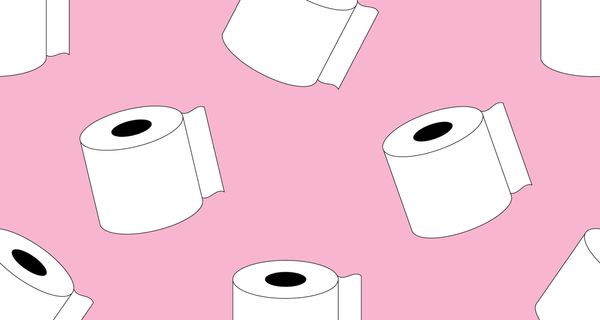Listen to our weekly podcast Am I Making You Uncomfortable? about women’s health, bodies and private lives. Available on Spotify, Apple, Acast and wherever you listen to your podcasts.
Britain has backed up bowels – and it’s costing the NHS big bucks.
Constipation cost the health service £168m in the year 2018/19, according to the latest data from the Bowel Interest Group. This includes treating avoidable admissions to A&E for constipation (£81m) and prescription laxatives (£87m).
More often than not, those constipated are women. We don’t talk about poo, so we don’t know what’s normal and often this leads to delays in people seeking treatment. “The number one problem for women is constipation when it comes to poo,” says pelvic physiotherapist and comedian Elaine Miller. “About one in seven adults are constipated, and of that number about 60% are female.”

As well as being uncomfortable and potentially painful, constipation can have serious consequences in women. It’s one of the most common reasons for developing a vaginal prolapse (where the bladder, uterus or bowel protrudes into the vagina, sometimes causing the vagina to slip out of its usual position).
“If you sit on the toilet and strain repeatedly to try and have a bowel movement, then there’s a risk that as well as pushing out the poo, you can push out your fanny,” Miller explains with characteristic frankness.
A lot of women won’t notice they’ve had a vaginal prolapse, but for others, it can cause a disturbing feeling of fullness (like you’re sitting on a ball) or like something is falling out of your vagina. It can also cause other issues – such as problems with sex or urinary incontinence – and may require physiotherapy.
But why are women so prone to constipation in the first place? And what can we do to get our bowels moving? Miller joins us in the latest episode of HuffPost UK Life’s weekly podcast, Am I Making You Uncomfortable?, alongside dietician and gut specialist Dr Megan Rossi, to explain more.
What is constipation?
The longer a poo sits in your colon, the more dehydrated it becomes, and that’s what constipation is, says Miller. “The actual substance itself is too hard to be able to pass comfortably,” she explains. “So you want it to be a bit soft, but not liquid. If it looks like a smooth snake, then that’s an ideal perfect poo.”
‘Normal’ pooing is anything between three times a day to three times a week, so the key is figuring out what’s normal for you. Another sign of constipation is having to sit for a long time, or smearing when you wipe.
“You should sit for less than one minute before your bowel opens. If you have to sit for a long time, there’s something going on there,” says Miller. “It shouldn’t hurt to pass the poo, and once you’ve finished the poo, you shouldn’t have a feeling that there’s anything left.
“There shouldn’t be lots of smearing, because your anus should shut once the poo has passed. If you’ve got lots of smearing going on, it’s a suggestion that you’ve not actually completed passing the whole jobby.”

So, why are women more prone to it?
A combination of lifestyle habits and plain and simple biology make women more prone to constipation. You may notice it most frequently in the days before your period as your hormones fluctuate.
“When your progesterone starts changing, that’s when you tend to get PMS symptoms, and a lot of women really want to eat chocolate, and they want to sit around because they don’t feel great. And that in itself can trigger off a short term constipation episode,” explains Miller.
“And then when the hormone swings round and you’re starting to shed the womb lining, the hormone that triggers that contraction of the uterus also affects your bowel. So, lots of women poo more when they’re getting their period, and it’s a real symptom that within the next few hours you’re going to start to bleed.”
Another major factor behind constipation is women not giving themselves enough time to fully finish their business.
“A lot of women try and poo as quickly as they can and then they’re leaving some faecal matter behind,” says Miller.
“It is really common in women with young children, because they’ve either got a wee face coming and joining in the whole process, or she’s gone to the toilet, she’s managed to shut the door so she can get some privacy, but then it goes very quiet outside the door so she knows that there’s kids up to mischief.”
For both men and women, constipation can also be linked to stress, anxiety or depression, a side effect of medicine, diet, or being less active.
How to tackle constipation
The first step should be looking at your diet, says Dr Megan Rossi, who is a dietician and nutritionist with a PhD in gut health. But it’s not always simple.
“A lot of people just get told: ’You’re not eating enough fibre and you’re not drinking enough fluid,” she says. ”For a small population, that might be the cause of their constipation. For other people though, it more comes down to the types of fibre they’re having. Things like psyllium husk and kiwifruit, there’s actual clinical evidence for those types of fibres [helping].”
Having lots of different types of plant-based foods in your diet should help you achieve good gut health, she adds.
“You don’t need to take any fancy supplements or be on any fancy diets. It’s more about what you’re adding into your diet,” she says. “Think about your plant-based food groups – there’s essentially six – you have your whole grains, your nuts and your seeds, your fruit, your veg, your beans, and your pulses. And then you have some nice spices. So trying to get in something from each of those groups, most days into your diet, is really going to feed the gut bacteria.”
You can improve things further by making sure you’re chewing your food properly. “If you’re not chewing your food at least 15 to 30 times, actually your digestion has to work a lot harder throughout the body to get that nutrition from your gut into your blood,” Dr Rossi says.
Moving more will also help to get your bowels moving – the NHS recommends a daily walk or run for tackling constipation.
How to poo properly
Still feeling constipated? Make sure you’re pooing properly – something modern, western toilets actually hinder as sitting kinks the lower bowel. Squatting – or raising the knees about the hips – straightens the kink and helps poos pass more easily.
“A lot of people recommend getting a little stool, because if you put your feet up on that then your knees are higher than your hips, so you’re mimicking what a
squat is,” says Miller. “If you don’t have a stool, then if you get two toilet rolls and put them on their end and put your feet up on the toilet rolls, that’s usually just about enough height to get your knees up above your hips.”
Another top tip is to avoid straining or holding your breath.
“The problem with doing that is it causes a spike in your intra- abdominal pressure,” says Miller. “You get a big spike in the amount of pressure that’s in your tummy pressing down, and that’s what’s linked with prolapse, it’s that downward force that pushes vaginas out from where they belong.”
Instead she recommends learning the mantra: “Big belly, hard belly, and moo to poo.” This means taking a big breath in to push your belly out, then think about making it hard, like you’re bracing yourself for a punch. Finally, moo (yes, moo) like a cow.
“Instead of closing up the back of your throat and straining down, you want to moo on the way out. Because if you have an open glottis – if you’re mooing or hissing like a snake, or sighing like one of my teenagers – then you reduce your intra-abdominal pressure.”
If this advice doesn’t do the trick speak to your pharmacist or GP – yes, even during the pandemic. You may require laxatives and in some rare instances, constipation can be a sign of other underlying health problems, so don’t ignore it.







